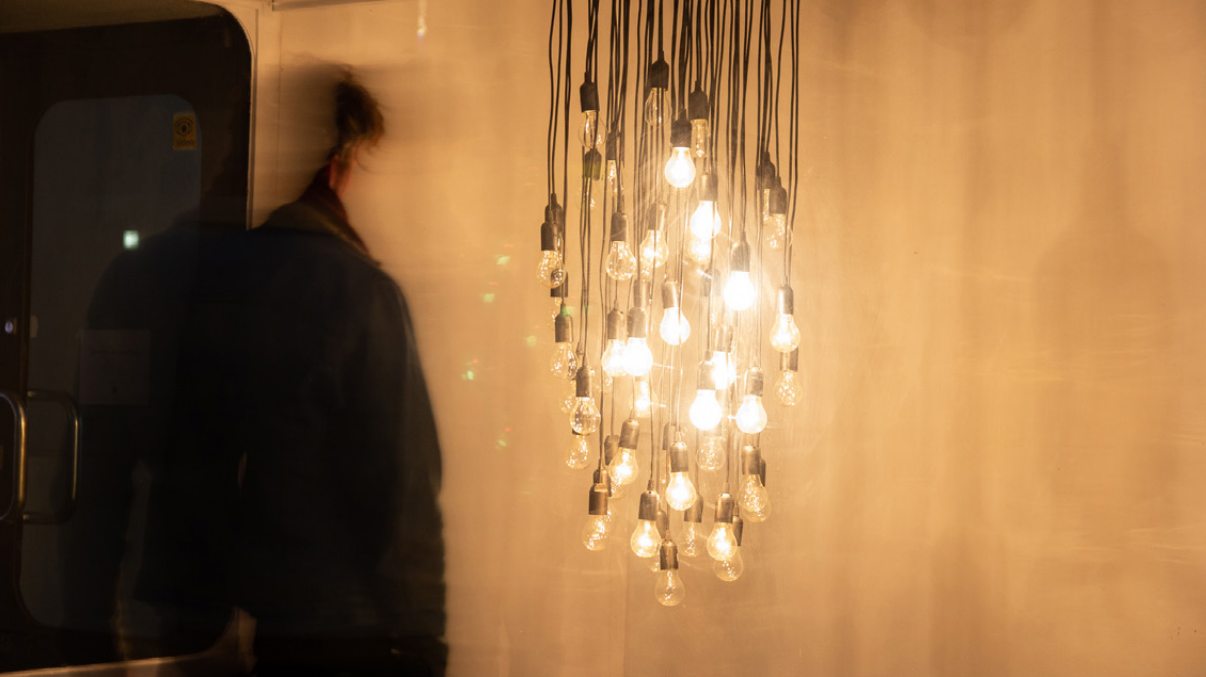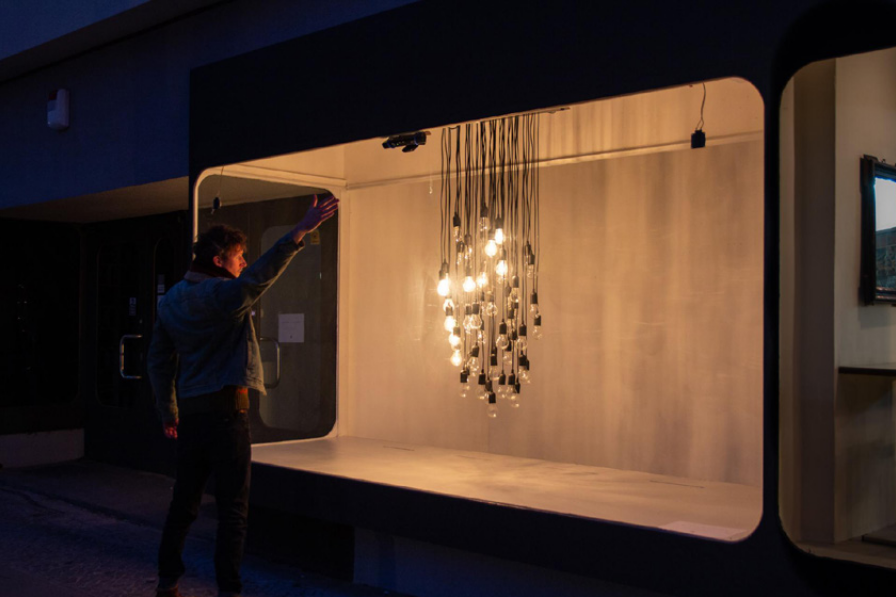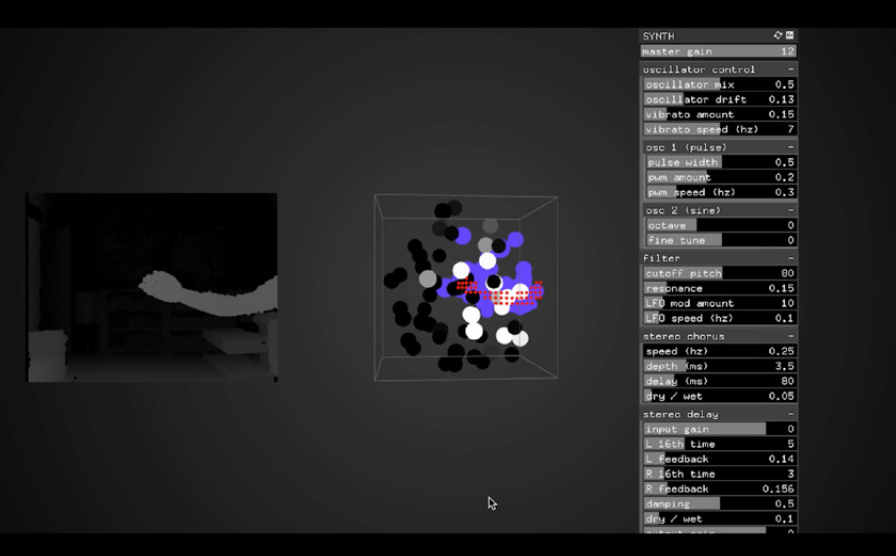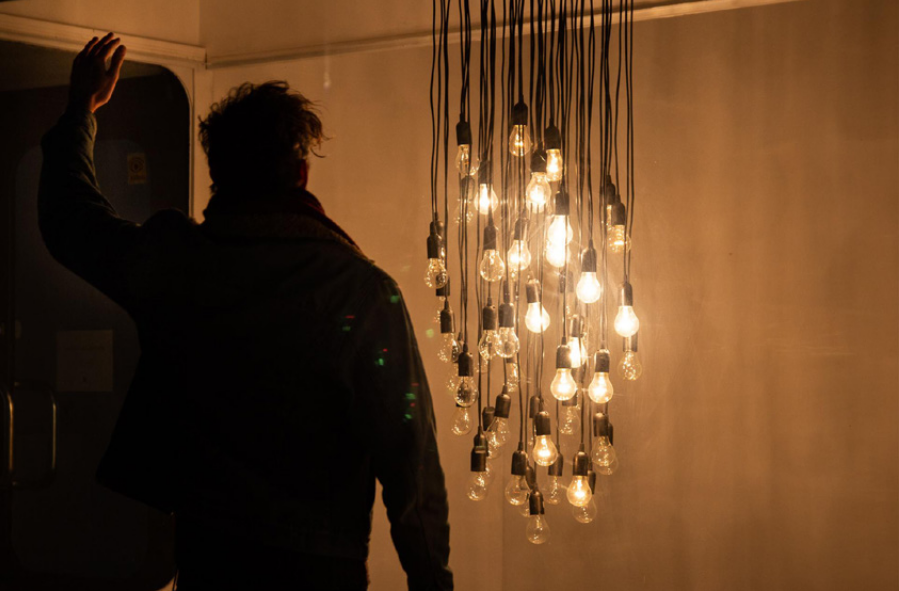Bathing in Lightness
The project is an interactive audio-visual installation by CTech alumnus Simon Stimberg. Bathing in Lightness intends to reflect our relationship towards the machine as such, regarding the way we tend to perceive the apparatuses around us as living beings with a life of its own.





The installation features a swarm intelligence inside a virtual – yet physical – goldfish bowl, that is exploring its tiny universe while trying to communicate with the outer world. The swarm imagines its own interpretation of reality, while reflecting the presence of visitors moving in front of the piece. Build out of a commonly sensed longing for analogue, thus easy understandable mechanisms, the installation’s basic component represents an archetype of electric machines: the incandescent light bulb. Thereby the installation acts as an analogue interface through which the visitor can make contact with a virtual being while breaching the digital realm, provoking to contemplate on her/his relationship towards the artificial entity. Along with a calm and soothing sonification of the swarm’s movements, we are allured to rest in front of the piece as we would by warming ourselves at a cozy campfire, remembering us of ancient and more leisurely paced times.
Inspiration
As computers around us are constantly getting smaller and more powerful, I felt this development somehow detaching our perception of the machine as a machine – a logically working man-made artefact. Rather often it evokes in us the image of some kind of black magic box – impenetrable, enigmatic and at the same time with a life of its own, as we tend to discern moods, caprices and tendencies. While we on one hand embrace the advantages of 21st century technology (especially the internet), there seems to be a growing but unfulfillable desire to again understand what’s happening inside the machine and to literally see the machine working.
Facing the ubiquity of digital algorithms in our daily life, Berry and Dieter describe in their essay Thinking Postdigital Aesthetics: Art, Computation and Design the discrepancy of the digital revolution, as algorithms create “a world that appears more comfortable, safer, faster and convenient – although this may paradoxically result in our feeling more stressed, depressed or drained of meaning” (Berry and Dieter 2015, 1). While this may refer to social media in the first place, I think it also mirrors the lack of physical connection we feel not only in social interaction but also when consuming auditive or visual content online – instead of putting on a vinyl, reading a book or looking at an artwork in a physical gallery space. Especially as virtual reality still remains some kind of unsatisfying for its lack of physical haptics, there seems to be a desire for using the advantages of digital technology with analogical interaction. This tendency might be well described by the term trans-digital as Jenny Sundén coins it in her essay Technologies of Feeling: Affect between the Analog and the Digital:
I suggest the term transdigital to account for analog passions that are shaped through the digital in ways that concretely activate, but also move across the borders of, or beyond the digital. (Sundén 2015)
With the use of glowing light bulbs instead of LEDs I wanted to express this transdigital ambiguity by opposing the viewer an archaic looking apparatus which on the other hand acts like an artificial living entity powered by digital algorithms. With this I would like to provide a vehicle through that the visitor can contemplate on his/her relationship to the artificial entity and the machine as such. What does it mean to be alive and how does a machine reflect human life? To what extent does the machine merely imitate human action, and from when on is the machine perceived as an autonomous living entity?
Technical Description
The sculpture consists of a cloud of light bulbs that are arranged in a non-lattice structure, which is derived from phyllotactic spiral patterns found in botany, to create an organic feeling composition. The 52 individual dimmable light bulbs serve in this setup like a low-resolution 3-dimensional display, visualizing the movement of a particle swarm. The swarm itself is driven by algorithms derived from flocking behavior, like those exhibited by fishes and birds. Due to this algorithm the swarm develops an emergent behavior as the single entities start to wander around together, exploring the space (and the boundaries) of their tiny gold fish bowl as well as reacting to sensor data from the outside.
The installation is designed to emphasize the visitor’s experience of getting in touch with the physical and virtual nature of the installation – therefore visitors can interact intuitively with the piece, which involves an immediate and coherent visual and sonic feedback. The motion of a person in front of the installation is captured by a depth camera. The swarm is attracted by that movement so that the visitor gets mirrored by the swarm of light inside the cluster of bulbs. At the same time the movements are being sonified as every bulb is represented by an oscillator of a synthesizer. The stronger the motion the more intense is the sound being heard. Depending on the position and direction of movement, different pitches and harmonics are being played to compose a complex musical soundscape. The sonification is less rhythmical but rather harmonic driven and of an overall mellow and calm quality.
Project Evolution
The installation was first shown as part of a group exhibition at Zönoteka Gallery, Berlin in July 2019. Since the first manifestation that was emphasizing particularly on the ambiguity of the digital-analog juxtaposition, the installation has run through several iterations – most of them mainly focusing on the interactive dimension and the experience of the visitor. Among other exhibitions, the interaction part was subject to a presentation at the Mensch und Computer conference for human and computer interaction in September 2020 (Stimberg and Brennecke 2020).
References
Berry, David M., and Michael Dieter. 2015. “Thinking Postdigital Aesthetics: Art, Computation and Design.” In Postdigital Aesthetics, 1-11. London: Palgrave Macmillan.
Stimberg, Simon, and Angela Brennecke. 2020. “Bathing in Lightness: An Interactive Light and Sound Installation.” In Proceedings of the Conference on Mensch Und Computer, 501–504. Magdeburg Germany: ACM.
Sundén, Jenny. 2015. “Technologies of Feeling: Affect Between the Analog and the Digital.” In Networked Affect, 135–150. Cambridge, Massachusetts: MIT Press.
The above text is from the publication within the xCoAx 2022 10th Conference on Computation, Communication, Aesthetics & X
Team
The project is by CTech alumnus Simon Stimberg (post@simonstimberg.de) and was part of his studies, advised by Prof. Dr.-Ing. Angela Brennecke.

